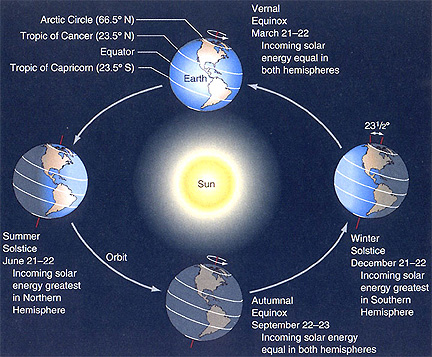[/caption]
June 21st, 2011 is Summer Solstice – the longest day of the year.
This is the time when the Sun is at its highest or most northerly point in the sky in the Northern Hemisphere and when we receive the most hours of daylight. If you live in the Southern Hemisphere it is the reverse, so you will be having “Winter Solstice.”
Also known as “Midsummer” the Summer Solstice gets its name from the Latin for sol (sun) and sistere (to stand still). The Sun reaches its most Northerly point and momentarily stands still before starting its journey South in the sky again until it reaches its most Southerly point “Winter Solstice”, before repeating the cycle. This is basically how we get our seasons.
It’s not actually the Sun that moves North or South over the seasons although it may appear so. It’s the Earths axial tilt that causes the Sun to change position in the sky as the Earth orbits the Sun throughout the year.

Summer Solstice/ Midsummer is steeped in ancient folklore especially in Northern Europe with the most famous place directly related to it being Stonehenge, where the sun has been worshiped for thousands of years.

The Sun reaches its most Northerly point in the sky at 17:16 UTC momentarily and from that point forward starts to make its way South. This means the days will get shorter and shorter until Winter Solstice in December.


The Summer Solstice is the coolest, most awesomest day of the year!
The Summer Solstice Girl
The Summer Solstice is the coolest, most awesomest day of the year!
The Summer Solstice Girl
When I’m explaining this to students, I make sure to point out that the Sun doesn’t actually “stand still,” it only appears to if we track its position in the sky at local noon over the course of a few days. Otherwise, they may think that it actually stops for some amount of time on this day!
This phenomenon is best illustrated (here) by what is known as an analemma (no, it’s not some girl called “Emma” who talks out of her rear end!); it’s a figure-8 curve traced out in the sky by the Sun over the course of one year.
Or, er… one more thing: there’s a missing possessive apostrophe in “Earths” in that paragraph.
Great Post 😀
thought you might like my King Arthur’s Summer Solstice at Stonehenge machinima film
Wishing All a Joyfull Summer Solstice Alban Hefin Litha /|
Great Post 😀
thought you might like my King Arthur’s Summer Solstice at Stonehenge machinima film
Wishing All a Joyfull Summer Solstice Alban Hefin Litha /|
In school, I learned that the Earth was closest to the sun during the northern winter solstice, but that the angle of the incoming irradiance negated the warming effect of being at perihelion. I wondered then, and still do, since the southern hemisphere is both at summer solstice and closest point to the sun at the same time, are the southern summers warmer than ours in the north?
yip. Im from South Africa and we definatly experience hotter summers than you guys
Actually, the Earth’s perihelion (closest point in its orbit) occurs around January 3rd, and the aphelion (farthest point in its orbit) occurs around July 4th; however, these dates drift over time due to precession and other orbital factors, which follow cyclical patterns known as Milankovitch cycles. Due to the inverse square law, the radiation at perihelion is about 106.9% the energy at aphelion; therefore, the varying Earth-Sun distance causes an increase of about 6.9% in solar energy reaching the Earth when it’s summer in the southern hemisphere.
Yo, Ivan! Thanks!
You’re welcome!